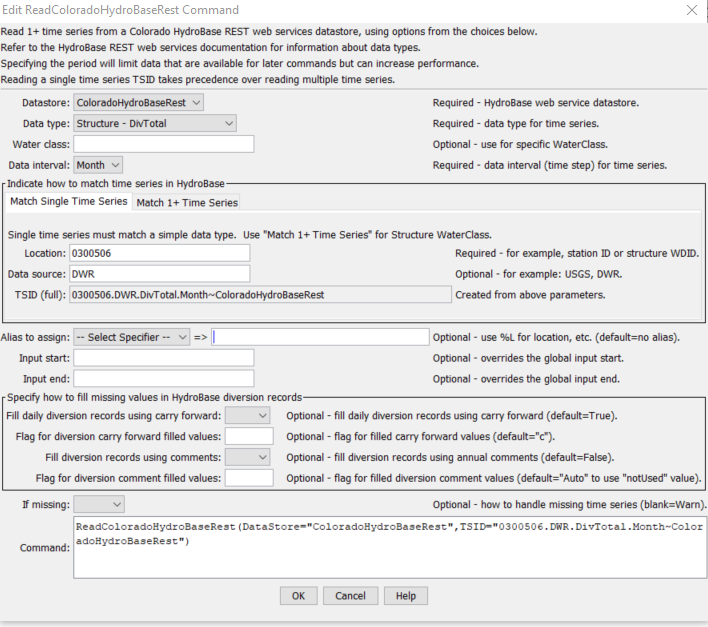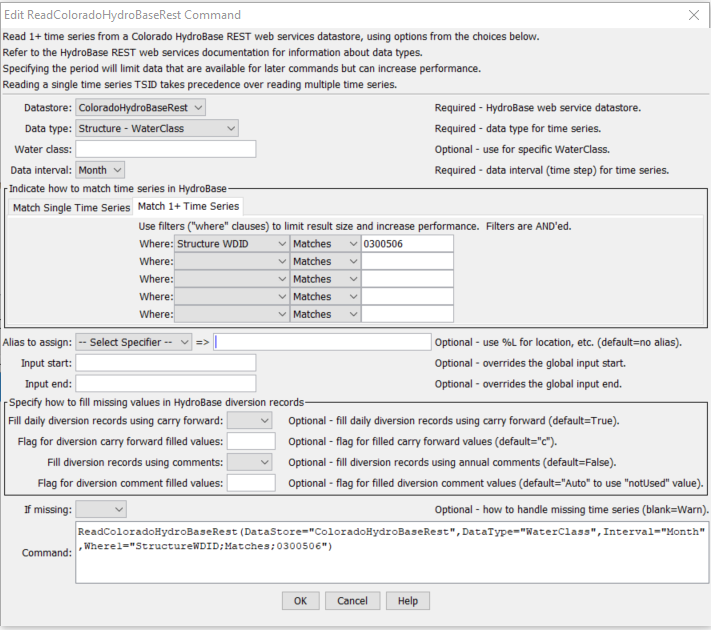TSTool / Command / ReadColoradoHydroBaseRest
Overview
The ReadColoradoHydroBaseRest command reads one or more time series from the Colorado HydroBase REST web services
(see the ColoradoHydroBaseRest Datastore Appendix).
It is designed to utilize web service query criteria to process large numbers of time series,
for example for a specific water district and data type.
The default parameter values match the results of TSID for the datastore.
Web service queries have slower performance than local database queries used with
HydroBase database,
but do not require local database installation and configuration.
The Data type, Data interval, and Where command parameters and input fields
are similar to those in the main TSTool interface.
However, whereas the main TSTool interface first requires a query to find the
matching time series list and interactive select to copy specific time series identifiers into the Commands area,
the ReadColoradoHydroBaseRest command reads the time series list and the corresponding data for the time series.
This can greatly shorten command files and simplify command logic, especially when processing many time series.
However, because the command can process many time series and web services are impacted by network speed,
running the command can take awhile to complete.
Data for the location (station, structure, well, etc.) and time series metadata,
as shown in the main TSTool interface, are set as time series properties, using web service data values.
These properties can be transferred to a table with the
CopyTimeSeriesPropertiesToTable
command and processed further with other table commands.
Diversion Records
Time series corresponding to diversion records,
which include observations for ditches, reservoirs, wells, and other "structures", are handled as described below.
Note that reading diversion records with TSTool will provide additional zero data values compared
to directly querying web services on the State of Colorado's website,
due to TSTool's default value for FillDivRecordsCarryForward command parameter.
TSTool's behavior is consistent with traditional engineering use of the data.
Note also that daily diversion records read from HydroBase database
may have more zeros than data read from web services.
This is because the HydroBase vw_CDSS_DailyAmt and vw_CDSS_DailyWC views often provide
zero values where data may have been missing, due to how the view is created.
These values typically are zero and have no observation code (obseration code is used for the data value flag in TSTool).
This design approach is being evaluated and in the future HydroBase may be distributed with fewer zero values,
in which case the fill carry forward default algorithm in TSTool should fill many of those zeros,
especially at the start of the irrigation year.
- In general, diversion record values correspond to observations and estimates determined by
the State of Colorado and other entities.
The accuracy of values is higher for well-maintained measuring devices and
lower (less accurate and possibly unverified) for third-party data submission.
Diversion records are stored in various forms including daily diversion records and infrequent measurements.
For example, long-term daily records may be available at large diversion structures
whereas other structures may have infrequent data records and/or annual diversion comments.
Records for smaller interval (e.g., day) are accumulated to larger interval (month and year).
The HydroBase observations available in diversion records can be further processed to provide additional
data values, as described below.
The WaterClass web service indicates
availableIntervalsfor diversion records and those with only monthly or annual measurements indicate "infrequent" measurements. Diversion record observations havemeasIntervalthat indicates whether the value was derived from daily, monthly, or annual data, with monthly and annual indicating infrequent measurements. Diversion records consist of date, value, and flag (observation code), which can be viewed in TSTool. - If
FillDivRecordsCarryForward=True(the default), daily total diversion (DivTotal), daily total reservoir release (RelTotal), and dailyWaterClasstime series have their values carried forward to fill additional zero data values within irrigation years (November to October). The Division of Water Resources does implement some data filling by carrying forward non-zero daily values, indicated with corresponding data flags. In practice, it is common to interpret diversion records by filling in additional zeros and TSTool automates this approach. This technique has been used when processing data for CDSS modeling. Web services by default only return HydroBase diversion record data for observations without additional zero-filling. Therefore, this filling action should only provide additional zero values in an irrigation year where a diversion or release was recorded sometime in the year. Irrigation years with no observations remain as missing after the read. The default behavior is the same as theReadHydroBasecommand. - If
FillUsingDivComments=True, daily, monthly, and yearlyDivTotal,RelTotal, andWaterClasstime series are filled using annual irrigation year (November-October) diversion comments, which indicate when irritation years should be treated as additional zero values. Diversion comments provide additional information but may not always be consistent with diversion records. For example, diversion comments may indicate that a structure did not divert water in a year whereas daily and monthly records show diversions in all or some months. The separateFillUsingDiversionCommentscommand also is available for filling but may be phased out in the future. - See the
FillHistMonthAverage,FillPattern, and other commands, which can be used to fill (estimate) values in data gaps after the initial time series are read.
Command Editor
The following dialog is used to edit the command and illustrates the syntax for the command.
Two options are available for matching time series, based on historical software requirements.
The following example illustrates how to read a single time series by specifying the time series identifier.
This approach is essentially equivalent to using the
ReadTimeSeries command but offers parameters specific to HydroBase web services.
Specifying a TSID can be used for simple data types such as DivTotal where the data type matches one time series.
The WaterClass data type can match multiple time series and therefore requires that the WaterClass
parameter is specified if a single time series should be matched.

ReadColoradoHydroBaseRest Command Editor to Read a Single Time Series (see also the full-size image)
The following figure illustrates how to query multiple time series, in this case all available water class time series for the specified structure WDID.

ReadColoradoHydroBaseRest Command Editor to Read Multiple Time Series (see also the full-size image)
Command Syntax
The command syntax is as follows:
ReadColoradoHydroBaseRest(Parameter="Value",...)
Command Parameters
| Parameter | Description | Default |
|---|---|---|
DataStorerequired |
The ColoradoHydroBaseRest datastore name to use for the database connection, as per datastore configuration files (see the ColoradoHydroBaseRest Datastore appendix). When using this approach the TSID will end in ~ColoradoHydroBaseRest. |
None - must be specified. |
DataTyperequired |
The data type to be queried, as documented in the ColoradoHydroBaseRest Datastore appendix. | None – must be specified. |
WaterClass |
The water class if only a single water class should be returned, used when DataType=WaterClass. Specify as the full string including leading WDID as returned when querying all water classes, for example: 0300909 S:2 F:0303732 U:Q T:7 G: To:. |
All matching water classes. |
Intervalrequired |
The data interval for the time series, as documented in the ColoradoHydroBaseRest Datastore appendix (e.g. Day, Month, Year), consistent with the DataType selection. |
None – must be specified. |
TSID |
When reading a single time series, the time series identifier to read. If specified, this parameter will override the WhereN parameters. |
Use WhereN parameters to read multiple time series. |
WhereN |
When reading 1+ time series, the “where” clauses to be applied. The filters match the values in the Where fields in the command editor dialog and the TSTool main interface. The parameters should be named Where1, Where2, etc., with a gap resulting in the remaining items being ignored. The format of each value is:Item;Operator;ValueWhere Item indicates a data field to be filtered on, Operator is the type of constraint, and Value is the value to be checked when querying. |
If not specified, the query will not be limited and very large numbers of time series may be queried. |
Alias |
The alias to assign to the time series, as a literal string or using the special formatting characters listed by the command editor. The alias is a short identifier used by other commands to locate time series for processing, as an alternative to the time series identifier (TSID). |
None – alias not assigned. |
InputStart |
Start of the period to query, specified as a date/time with a precision that matches the requested data interval. | Read all available data. |
InputEnd |
End of the period to query, specified as a date/time with a precision that matches the requested data interval. | Read all available data. |
FillDivRecordsCarryForward |
Indicate whether to fill daily DivTotal, RelTotal, and WaterClass time series using carry forward approach:
|
True |
FillDivRecordsCarryForwardFlag |
Data flag set when values are filled if FillDivRecordsCarryForward=True . The flag can then be used later to label graphs, etc. |
c |
FillUsingDivComments |
Indicate whether to fill DivTotal, RelTotal, and WaterClass time series using diversion comments. The parameter can be used for day, month, and year interval data. Additional zeros will result for irrigation years (November-October) where the diversion comment indicates that water was not taken. |
False |
FillUsingDivCommentsFlag |
Data flag set when values are filled if FillUsingDivComments=True. The flag can then be used later to label graphs, etc. The flag will be appended to existing flags if necessary. |
Value from notUsed flag in data. |
IfMissing |
Indicate the action to be taken if the requested time series is missing, one of:
|
Warn |
Examples
See the automated tests.
Troubleshooting
See Also
CopyTimeSeriesPropertiesToTablecommandFillUsingDiversionCommentscommandReadHydroBasecommandReadTimeSeriescommand